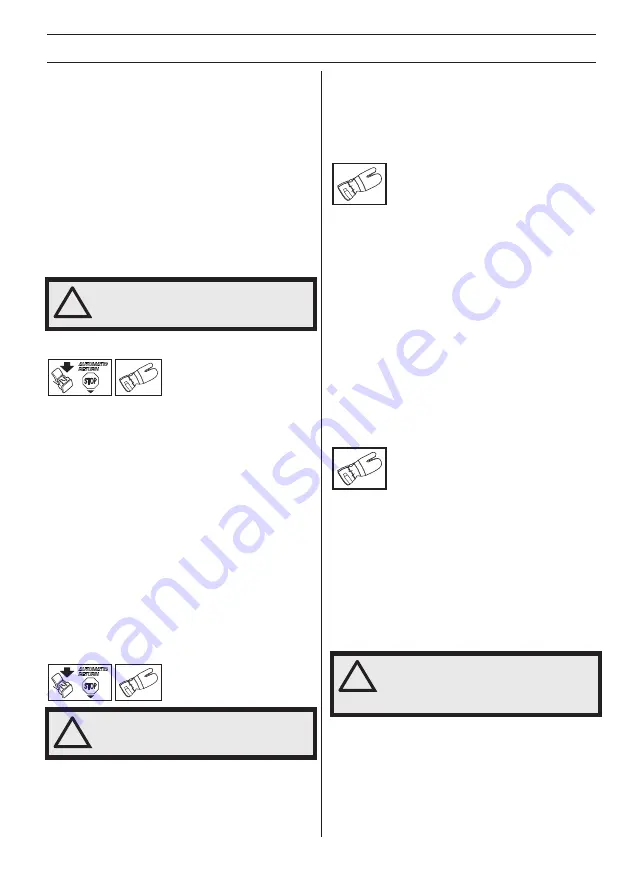
GENERAL SAFETY PRECAUTIONS
English
–
15
1158605-38 Rev. 2 2016-09-19
•
Always file cutting teeth from the inside face. Reduce
the pressure on the return stroke. File all the teeth on
one side first, then turn the chain saw over and file the
teeth on the other side.
•
File all the teeth to the same length. When the length
of the cutting teeth is reduced to 4 mm (5/32") the
chain is worn out and should be replaced.
(23)
General advice on adjusting depth gauge setting
•
When you sharpen the cutting tooth (A) the depth
gauge setting (C) will decrease. To maintain optimal
cutting performance the depth gauge (B) has to be
filed down to achieve the recommended depth gauge
setting. See instructions under the heading Technical
data to find the correct depth gauge setting for your
particular chain.
(24)
Adjustment of depth gauge setting
•
The cutting teeth should be newly sharpened before
adjusting the depth gauge setting. We recommend
that you adjust the depth gauge setting every third
time you sharpen the cutting teeth. NOTE! This
recommendation assumes that the length of the
cutting teeth is not reduced excessively.
•
You will need a flat file and a depth gauge tool. We
recommend that you use our depth gauge tool to
acheive the correct depth gauge setting and bevel for
the depth gauge.
•
Place the depth gauge tool over the chain. Detailed
information regarding the use of the depth gauge tool,
will be found on the package for the depth gauge tool.
Use the flat file to file off the tip of the depth gauge that
protrudes through the depth gauge tool. The depth
gauge setting is correct when you no longer feel
resistance as you draw the file along the depth gauge
tool.
(24)
Tensioning the chain
The more you use a chain the longer it becomes. It is
therefore important to adjust the chain regularly to take up
the slack.
Check the chain tension every time you refuel. NOTE! A
new chain has a running-in period during which you
should check the tension more frequently.
Tension the chain as tightly as possible, but not so tight
that you cannot pull it round freely by hand.
(25)
135
•
Loosen the bar nut that holds the clutch cover and
chain brake. Use the combination spanner. Then
retighten the bar nut as tightly as you can by hand.
(26)
•
Raise the tip of the bar and stretch the chain by
tightening the chain tensioning screw using the
combination spanner. Tighten the chain until it does
not sag from the underside of the bar.
(27)
•
Use the combination spanner to tighten the bar nut
while holding up the tip of the bar. Check that you can
pull the saw chain round freely by hand, and that there
is no slack on the underside of the bar.
(28)
The position of the chain tensioning screw on our chain
saws varies from model to model. See instructions under
the heading What is what? to find out where it is on your
model.
135e, 135e TrioBrake
•
Release the knob by folding it out.
(29)
•
Turn the knob anti clockwise to loosen the bar cover.
(30)
•
Adjust the tension on the chain by turning the wheel
down (+) for tighter tension and up (-) to loosen the
tension.
(31)
•
Tighten the bar clutch by turning the knob clockwise.
(32)
•
Fold the knob back in to lock the tensioning.
(33)
Lubricating cutting equipment
Chain oil
Chain oil must demonstrate good adhesion to the chain
and also maintain its flow characteristics regardless of
whether it is warm summer or cold winter weather.
As a chain saw manufacturer we have developed an
optimal chain oil which, with its vegetable oil base, is also
biodegradable. We recommend the use of our own oil for
both maximum chain life and to minimise environmental
!
WARNING! The risk of kickback is
increased if the depth gauge setting is
too large!
!
WARNING! A slack chain may jump off
and cause serious or even fatal injury.
!
WARNING! Poor lubrication of cutting
equipment may cause the chain to snap,
which could lead to serious, even fatal
injuries.
















































